Nipro Bundle
How did Nipro Company evolve from recycling lightbulbs to a global healthcare leader?
Discover the fascinating journey of Nipro, a prominent Nipro SWOT Analysis. From its humble beginnings in post-war Japan, this Japanese company has become a global force in medical technology. Explore the key milestones and strategic decisions that shaped Nipro's remarkable transformation in the healthcare industry.
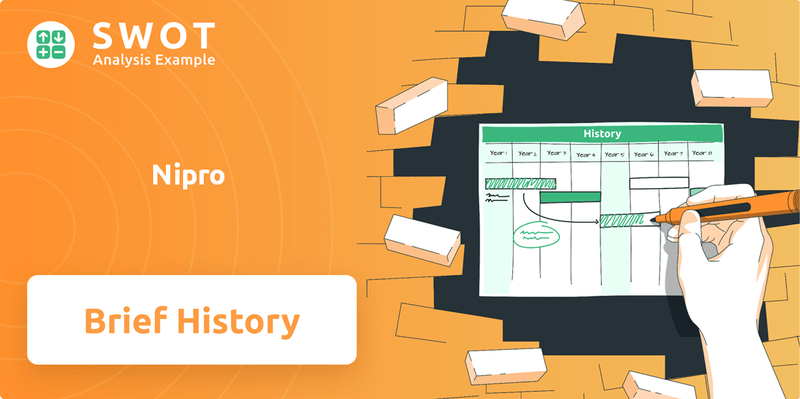
The brief Nipro history reveals a story of adaptability and foresight. Founded in 1947, Nipro's evolution from glass manufacturing to medical devices showcases its commitment to innovation. Understanding Nipro's past provides crucial context for analyzing its current market position and future prospects, making it a compelling case study for investors and business strategists alike.
What is the Nipro Founding Story?
The story of the Nipro Company, a prominent Japanese company in the medical technology and healthcare industry, began in the post-war era of Japan. Its roots trace back to 1947, offering a glimpse into its humble beginnings and the vision of its founder.
This initial venture laid the groundwork for what would become a global player. The company's early focus on glass manufacturing and trading, coupled with its diversified approach, highlights its adaptive strategies for growth in a recovering economy. Discover more about the Target Market of Nipro.
The formal establishment of Nihon Glass Shoji Co. Ltd., the precursor to Nipro Corporation, occurred on July 8, 1954. The company's initial focus was on marketing glass tubes for ampoules and pill bottles, recognizing an opportunity in the nascent medical glass market.
Nipro's journey started in 1947 with Sano Minoru, who was only 20 years old, establishing a light bulb recycling business.
- The formal establishment of Nihon Glass Shoji Co. Ltd. occurred on July 8, 1954.
- The company initially focused on marketing glass tubes for ampoules and pill bottles.
- Early products included small light bulbs and glass for vacuum flasks.
- The company also ventured into the supermarket business.
Nipro SWOT Analysis
- Complete SWOT Breakdown
- Fully Customizable
- Editable in Excel & Word
- Professional Formatting
- Investor-Ready Format
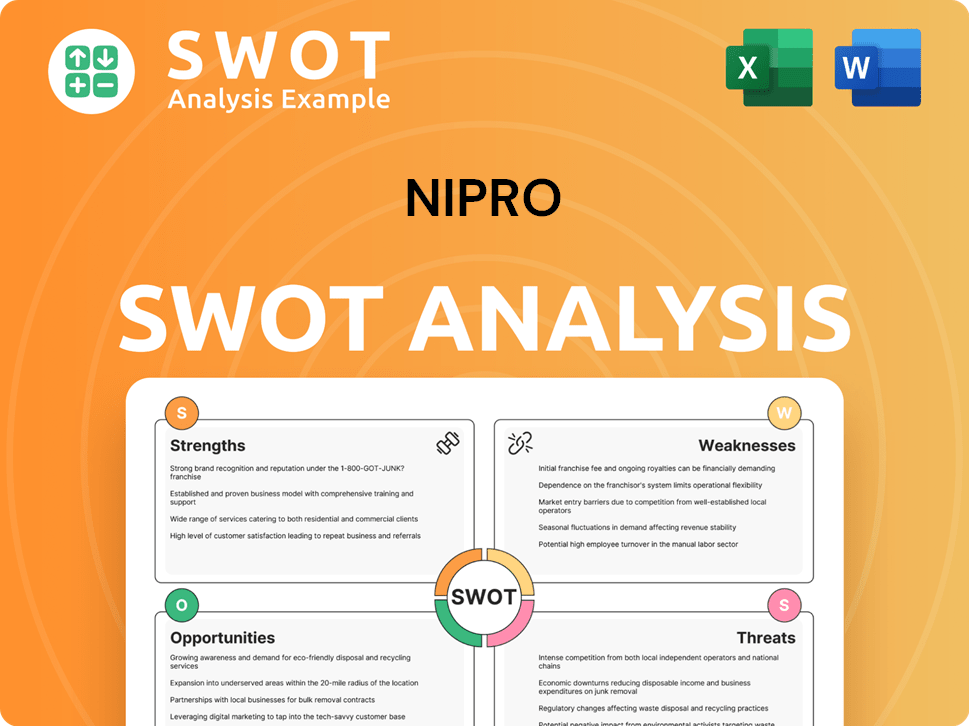
What Drove the Early Growth of Nipro?
The early growth of the Nipro Company, a prominent Japanese company, marked a strategic shift from its initial ventures into glass and supermarkets towards the medical field. This pivotal decision shaped the company's future in the healthcare industry. This expansion began with capital participation and corporate acquisitions, setting the stage for its significant role in medical technology. The company's commitment to innovation and growth during this period laid the foundation for its success.
In 1965, Nipro began selling infusion kits to pharmaceutical companies, formally entering the medical device industry. This marked a significant step in the
The 1970s saw substantial expansion in Nipro's manufacturing capabilities. Production of disposable syringes and coil dialyzers began in 1974. The following year, the company added blood tubing, infusion kits, and hollow fiber dialyzers to its product line, becoming one of the first in Japan to produce the latter. By 1976, vacuum blood collection tubes and catheters were also added.
During the 1970s, Nipro established key facilities to support its growing manufacturing operations. The Technological Development Center (now the Research & Development Laboratory) in Kusatsu, Shiga Prefecture, and the Odate Factory in Akita Prefecture, were established. These facilities solidified an integrated manufacturing system for medical devices, enhancing its operational efficiency.
International expansion began in the 1980s, with dialyzers and related products being sold to the United States in 1983. Sales of insulin injection needles to Denmark in 1984 and arteriovenous fistula (AVF) needles for dialysis to Sweden in 1986 followed. In 1988, Nipro established its first overseas manufacturing and marketing base in Thailand.
Nipro PESTLE Analysis
- Covers All 6 PESTLE Categories
- No Research Needed – Save Hours of Work
- Built by Experts, Trusted by Consultants
- Instant Download, Ready to Use
- 100% Editable, Fully Customizable
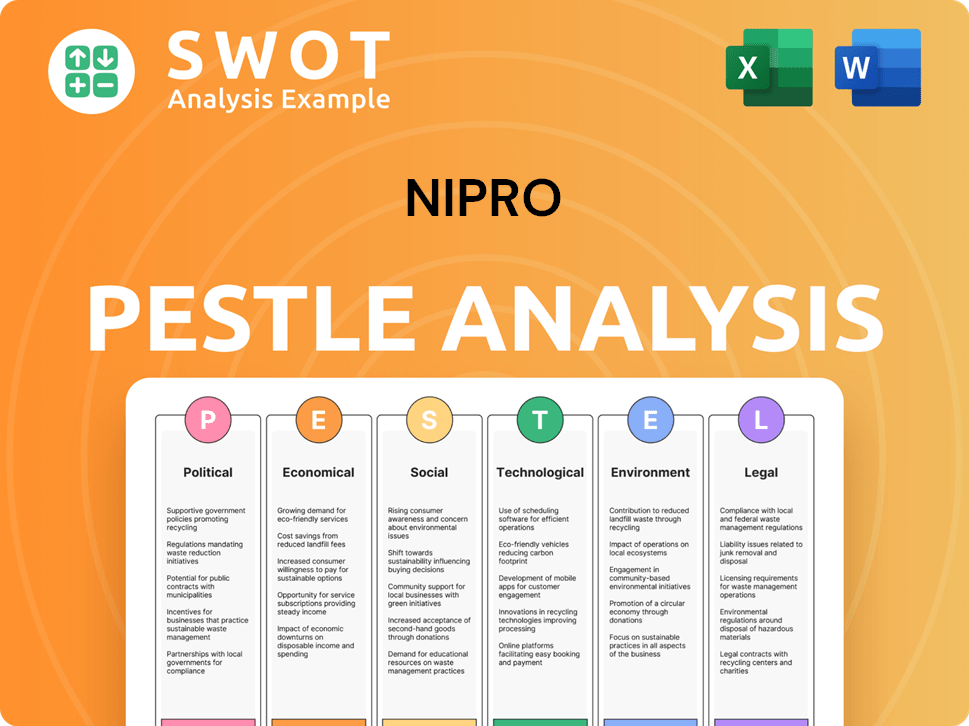
What are the key Milestones in Nipro history?
The Nipro Company has a rich Nipro history, marked by strategic growth and a commitment to innovation within the healthcare industry. This Japanese company has consistently expanded its global footprint and product offerings, making a significant impact on the medical technology sector.
| Year | Milestone |
|---|---|
| Early Days | Nipro became one of the first companies in Japan to manufacture hollow fiber dialyzers, addressing a critical need for hemodialysis patients. |
| 1994 | Acquired Hishiyama Pharmaceutical Corporation, later becoming Nipro Pharma Corporation. |
| 1995 | Launched integrated kits, expanding its product portfolio. |
| 1997 | Introduced pre-filled syringes. |
| Mid-1990s | Established business bases in China, Brazil, the United States, and Singapore, accelerating global reach. |
| 2021 | Acquired Piramida, a Croatian manufacturer of glass pharmaceutical packaging, enhancing its position in the primary pharmaceutical packaging market. |
| 2022 | Increased capital investments and added syringe manufacturing lines in Japan and France to address syringe supply shortages. |
Nipro's dedication to innovation is evident through its early adoption of advanced medical technologies and continuous product development. The company has also invested heavily in research and development, establishing dedicated centers to drive innovation.
Nipro was among the first in Japan to manufacture hollow fiber dialyzers, a significant innovation for hemodialysis patients. This early adoption underscored the company's commitment to providing advanced medical solutions.
The launch of integrated kits in 1995 and pre-filled syringes in 1997 expanded Nipro's product offerings. These innovations streamlined medical procedures and improved efficiency.
The establishment of the Pharmaceutical Research Center in Kusatsu, Shiga Prefecture, demonstrated Nipro's commitment to R&D. This center supports the development of new pharmaceutical products and technologies.
The company's investment in the Research and Development Center for Regenerative Medicine highlights its focus on cutting-edge medical advancements. This center is dedicated to exploring innovative regenerative medicine solutions.
Nipro has secured numerous patents, with over 7,100 total documents for applications and grants, and 4,001 total patent families. This extensive portfolio reflects the company's commitment to protecting its intellectual property and driving innovation.
Acquisitions, such as the purchase of Piramida in 2021, have been instrumental in expanding Nipro's market presence. This strategy has enabled the company to strengthen its position in key markets.
Despite its successes, Nipro has faced challenges, including market fluctuations and competitive pressures. The company has responded with strategic adjustments and a focus on core strengths.
In FY2024, Nipro faced challenges due to increased costs in the pharmaceutical-related business and a decline in performance in the Asian region within the PharmaPackaging business. These pressures have prompted strategic adjustments.
In response to the challenges, Nipro revised its recurring profit forecast for FY2025. This adjustment reflects the company's proactive approach to managing financial performance.
Nipro has focused resources on its core medical and pharmaceutical businesses. This strategic pivot allows the company to leverage its strengths and expertise.
The implementation of digital transformation initiatives aims to increase efficiency and productivity. These efforts support Nipro's commitment to operational excellence.
Nipro's 'Willingness' creed and 'Sanpo-yoshi' concept (good for everyone) guide its approach to overcoming obstacles. These principles foster a culture of continuous improvement and ethical business practices.
Nipro's expansion into markets like China, Brazil, and the United States has been a key strategy. This global presence has allowed the company to diversify its revenue streams and reach a wider customer base.
For further insights into the company's strategic direction, you can explore the Growth Strategy of Nipro.
Nipro Business Model Canvas
- Complete 9-Block Business Model Canvas
- Effortlessly Communicate Your Business Strategy
- Investor-Ready BMC Format
- 100% Editable and Customizable
- Clear and Structured Layout
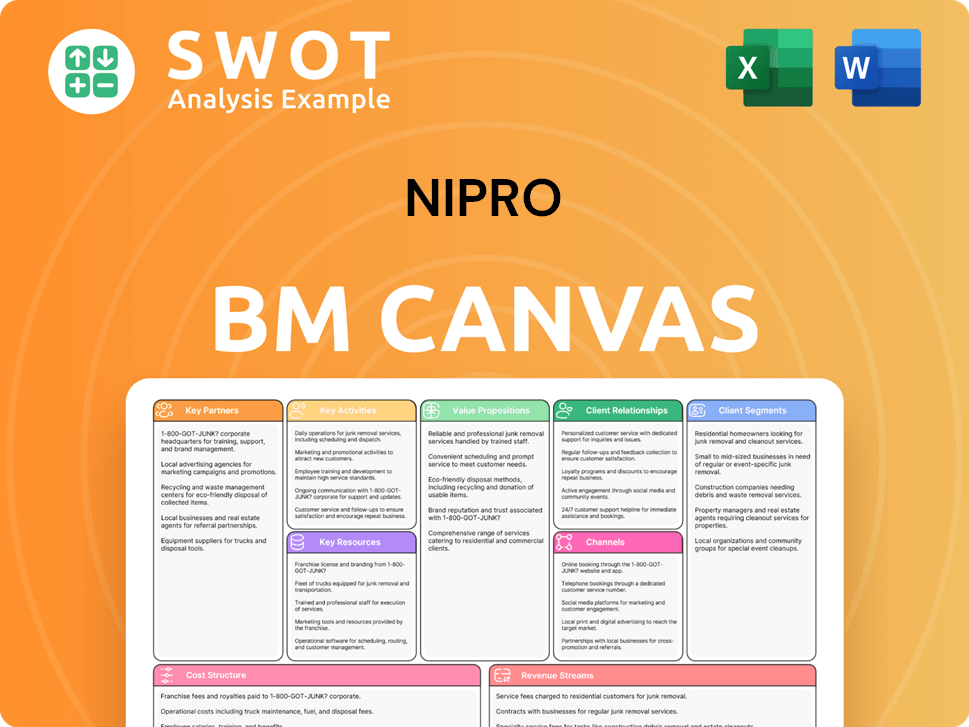
What is the Timeline of Key Events for Nipro?
The Nipro Company has a rich history, evolving from a light bulb recycling business to a global leader in the healthcare industry. This Japanese company has consistently expanded its operations and product offerings, making significant contributions to medical technology. Here's a look at the key milestones in the Nipro history.
| Year | Key Event |
|---|---|
| 1947 | Founded as a light bulb recycling business by Sano Minoru in Otsu, Shiga Prefecture. |
| 1954 | Nihon Glass Shoji Co. Ltd. (current Nipro Corporation) established, beginning marketing of glass tubes for ampoules, with the head office moved to Osaka. |
| 1965 | Began selling infusion kits for pharmaceutical companies, entering the medical device industry. |
| 1969 | Acquired a manufacturer, initiating large-scale production of medical devices. |
| 1974 | Expanded manufacturing to include disposable syringes and coil dialyzers. |
| 1975 | Began manufacturing hollow fiber dialyzers, becoming one of the first in Japan. |
| 1983 | Expanded sales of dialyzers and related products to the United States. |
| 1988 | Established first overseas manufacturing and marketing base in Thailand and fully launched pharmaceutical business. |
| 1994 | Acquired Hishiyama Pharmaceutical Corporation (later Nipro Pharma Corporation). |
| 1995 | Launched integrated kits and established Nipro Medical Ltda. in Brazil. |
| 1996 | Listed on the First Section of the Tokyo Stock Exchange. |
| 1997 | Launched sodium hyaluronate pre-filled syringes. |
| 2001 | Established Cell Science & Technology Institute, Inc. |
| 2010 | Established manufacturing sites in India and expanded diabetes-related business in the United States. |
| 2021 | Acquired Piramida, a Croatian manufacturer of glass pharmaceutical packaging. |
| 2023 | Relocated head office to a new building in Kento Innovation Park, Settsu City. |
| 2024 (July) | Announced plans to establish its North American manufacturing facility in North Carolina, USA, with an investment of US$398 million. |
| 2025 (January) | President Sano announced the 2025 Nipro Group Management Policy, emphasizing stable supply of dialysis products, improved productivity of vascular products, and promotion of digital transformation. |
| 2025 (March) | Opened a new MIC development center for dialysis technologies in Malmo, Sweden. Tsuyoshi Yamazaki became the new President and Representative Director. |
Looking ahead, Nipro aims for consolidated sales of JPY 1 trillion by FY2031. The medium-term management plan (FY2025-FY2027) sets the stage for this, with an average annual sales growth target of 7.0% or above and an operating profit margin goal of 9.0% or above.
The company plans to strengthen dialyzer sales, expand its vascular product lineup, and increase investment in regenerative medicine. Nipro is also focused on building a global production structure for contract manufacturing of pharmaceuticals and expanding its pharmaceutical packaging production.
Analysts predict Nipro's sales to reach JPY 644,586 million for FY2025, with an estimated net income of JPY 5,113 million. This demonstrates the company's continued financial health and growth potential in the healthcare industry.
Nipro is committed to sustainability, aiming for a 42% reduction in Scope 1 and Scope 2 emissions and a 25% reduction in Scope 3 from 2025 levels by 2035, with a net-zero goal by 2045. This commitment reflects the company's focus on corporate social responsibility.
Nipro Porter's Five Forces Analysis
- Covers All 5 Competitive Forces in Detail
- Structured for Consultants, Students, and Founders
- 100% Editable in Microsoft Word & Excel
- Instant Digital Download – Use Immediately
- Compatible with Mac & PC – Fully Unlocked
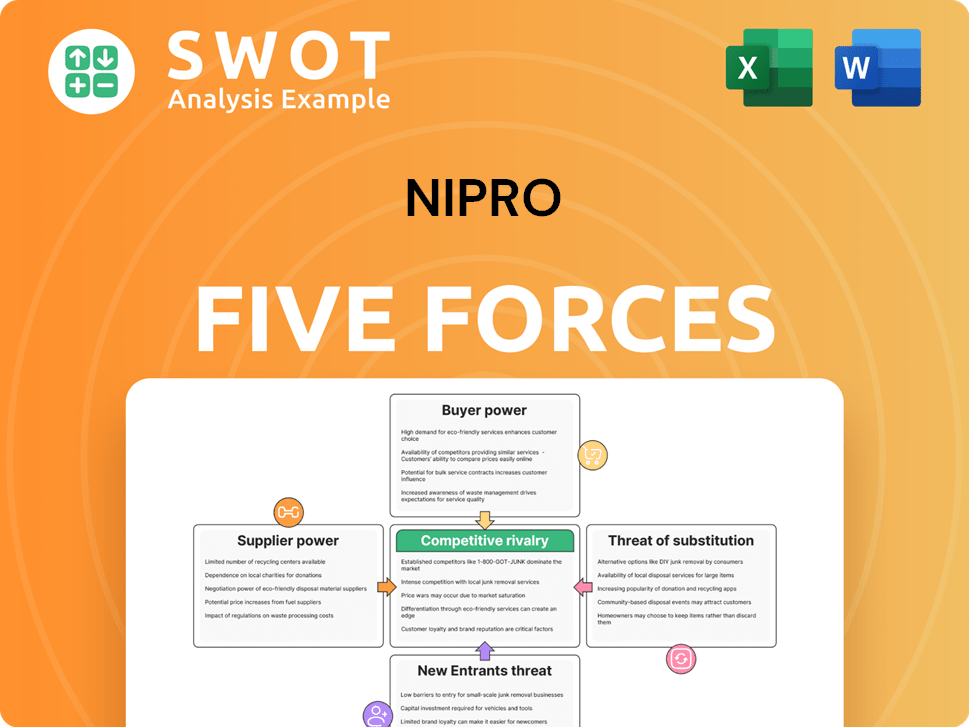
Related Blogs
- What is Competitive Landscape of Nipro Company?
- What is Growth Strategy and Future Prospects of Nipro Company?
- How Does Nipro Company Work?
- What is Sales and Marketing Strategy of Nipro Company?
- What is Brief History of Nipro Company?
- Who Owns Nipro Company?
- What is Customer Demographics and Target Market of Nipro Company?
Disclaimer
All information, articles, and product details provided on this website are for general informational and educational purposes only. We do not claim any ownership over, nor do we intend to infringe upon, any trademarks, copyrights, logos, brand names, or other intellectual property mentioned or depicted on this site. Such intellectual property remains the property of its respective owners, and any references here are made solely for identification or informational purposes, without implying any affiliation, endorsement, or partnership.
We make no representations or warranties, express or implied, regarding the accuracy, completeness, or suitability of any content or products presented. Nothing on this website should be construed as legal, tax, investment, financial, medical, or other professional advice. In addition, no part of this site—including articles or product references—constitutes a solicitation, recommendation, endorsement, advertisement, or offer to buy or sell any securities, franchises, or other financial instruments, particularly in jurisdictions where such activity would be unlawful.
All content is of a general nature and may not address the specific circumstances of any individual or entity. It is not a substitute for professional advice or services. Any actions you take based on the information provided here are strictly at your own risk. You accept full responsibility for any decisions or outcomes arising from your use of this website and agree to release us from any liability in connection with your use of, or reliance upon, the content or products found herein.